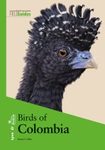About this book
From the preface:
"It has been 16 years since the appearance of the first edition of this gazetteer. The present volume is nearly double the size of the earlier one. A small part of this growth is attributable to the addition of localities through the work of contemporary ornithologists. Most of the growth, however, is the result of the availability of more information about previously known locations, thanks to the advent of the computer. In the earlier work information was obtained from published sources, from the first-hand examination of specimens within the Field Museum and the Museum of Comparative Zoology, from field catalogs of M. A. Carriker, Jr. archived in the United States National Museum, and from a few specimens in other museums that had been examined in connection with other research. Sources of information have greatly expanded now that computer printouts for Colombian specimens have been made available by the Academy of l\Iatural Sciences, the Carnegie Museum, the Cornell Ornithology Collection, the Natural History Museum of Los Angeles, the Museum of Natural Science, Louisiana State University, the Museum of Vertebrate Zoology, University of California, the University of Michigan Museum of Zoology, the Western Foundation for Vertebrate Zoology, and the Peabody Museum, Yale University.
In addition to this newly-available mine of information, the authors now have Hilty and Brown’s superb A Guide to the Birds of Colombia (1986), which has greatly expanded our knowledge of the distribution of the avifauna through the inclusion of data obtained during their fieldwork, and from unpublished records of their colleagues. Because of the nature of this guide, dates and localities are frequently abbreviated. As a consequence, information obtained from this source is often less precise than one might need for the gazetteer.
The ease with which data within the computer may now be manipulated, compared, and dissected has aided in the identification of some sites and has also revealed some interesting facts about earlier collectors. For example, the accuracies of the dates in Serna’s major paper (1980) are questionable, since it seems an unlikely coincidence, especially at infrequently visited sites, that collections were so often made at a given locality on the same date in different months (e. g., 24 April and 24 June) or on the same month and day but in different years. Some of the difficulties appear the result of Serna’s confusion in transliterating months from Arabic numerals to the Roman numerals he employed in this work.
A further example of the revelations exposed by the computer is evident in the material collected by Marinkelle. It is now obvious that his records bear scrutiny, as he appears to have been at distant points, sometimes on opposite sides of the Andes, at about the same time or even on the same dates (e. g., Finca Santa Bárbara vrs. Villavicencio); perhaps he purchased specimens and substituted his name for that of the collector, a custom that has been noted for some early collectors, particularly in Ecuador. How widespread this custom was is now becoming evident as computer databases have grown and it is easier to search for congruent dates on specimens from distant localities. W. W. Brown, who has been considered to epitomize the accurate and careful collector, has some overlapping dates at Puerto Viejo, Páramo de Chirigua, Cheru, La Concepción, etc. On the other hand, von Sneidem, a prolific collector, has long been known to have been careless in labeling material but how careless he was has not been appreciated heretofore. For instance, his identification of a single locality, as ascertained by collecting dates, may take many forms (e. g., Alto de
Buey; Alto de Buey, Pacific side; Alto de Buey, Bado side; Alto de Buey, Río Baudo, Alto de Buey, Río Jurubuda, etc.). Furthermore, he frequently and inconsistenly appended "El Tambo, the name of his finca, to localities that are distant from his home base at El Tambo (e g., San Antonio, El Tambo; Rio Munchique, El Tambo; La Costa, El Tambo, or even El Tambo, La Costa). There are instances when the same collecting date is given to specimens bearing either the single or the double names for the collection site, leading to the conclusion that El Tambo is not the locality of origin. In other instances the labelling is even more ambiguous, resulting in the recording herein of identical collection dates at widely separated places.
A change should be noted in the treatment of the comprehensive bibliography. The previous bibliography contained every known publication concerned with the Colombian avifauna, plus collateral citations that provided information not found elsewhere (e.g., a specific date or the name of a collector) but whose primary focus was not Colombian. These are now omitted from the bibliography but given in full within the text. In other words, bibliography lists all publications on Colombian birds, without superfluous material."
Customer Reviews























